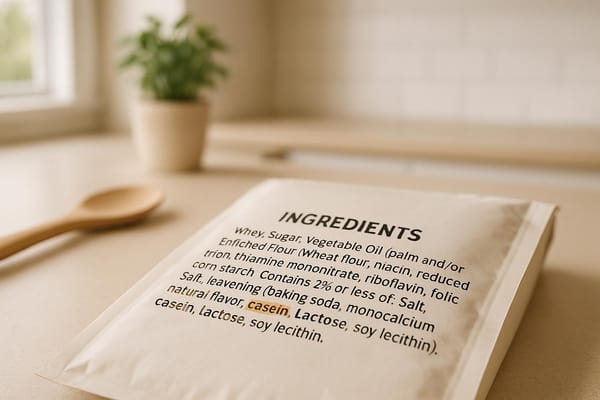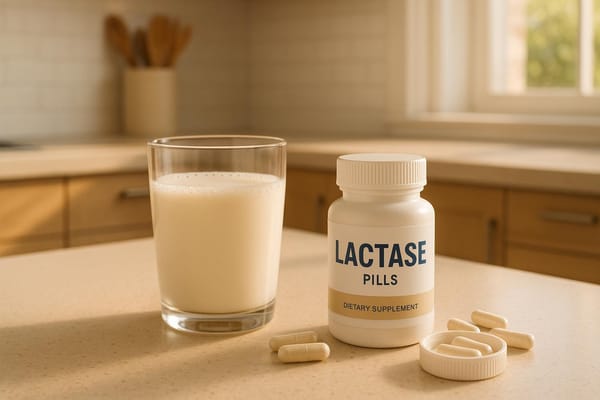How Much Lactase Is Enough for Lactose Intolerance?
Learn how to determine the right lactase dosage for managing lactose intolerance and enjoy dairy without discomfort.

Struggling with lactose intolerance? Lactase supplements can help you enjoy dairy without discomfort.
Here’s what you need to know:
- Typical Dose: Start with 3,000-9,000 FCC units per meal.
- Adjust Based on Symptoms: Increase or decrease the dose depending on how your body reacts.
- Timing Matters: Take lactase with your first bite of dairy for best results.
- Meal Composition: High-fat meals may require slightly higher doses.
- Severe Cases: For meals with over 20g of lactose, doses up to 18,000 FCC units might be necessary.
Want to fine-tune your approach? Keep a symptom log, adjust your dose gradually, and choose the right supplement form (tablets, chewables, or drops) for your lifestyle.
Lactase Dosage Basics
Basic Dosage Guidelines
Lactase dosage is measured in FCC units, which indicate the amount of enzyme needed to break down 1 micromole of lactose per minute at body temperature. This standardization helps guide appropriate dosing.
For adults, typical dosages range between 3,000 to 9,000 FCC units per serving of dairy [1][3].
| Dairy Product | Lactose Content | Recommended Lactase Units |
|---|---|---|
| Milk (8 oz) | 12g | 3,000-6,000 FCC |
| Ice Cream (½ cup) | 6g | 1,500-3,000 FCC |
| Yogurt (1 cup) | 8-12g | 2,000-4,000 FCC |
Factors That Influence Your Dose
Several factors can affect the amount of lactase you need. Residual enzyme production is one of the most important. For example, people with congenital lactase deficiency often require higher doses than those experiencing a natural decline in enzyme levels with age [6][7]. This variability highlights the importance of tailoring your dose to your specific needs.
Another key factor is the composition of your meal. Research shows that enzyme requirements vary depending on the amount of lactose consumed. In one study, 6,000 FCC units alleviated symptoms in 68% of participants, while increasing the dose to 9,000 FCC units provided relief for 89% of those with moderate lactose intolerance [6]. This demonstrates how both biology and diet impact enzyme effectiveness.
Advanced lactase formulations can also improve efficiency. For instance, acid-resistant capsules help maintain enzyme activity in the stomach. In severe cases, doses as high as 18,000 FCC units may be necessary for meals with very high lactose content (over 20g) or when certain medications interfere with digestion [2][6].
Finding Your Right Dose
Start with Label Instructions
The best place to begin is with the dosing instructions provided on the product label. These are based on clinical studies and are a solid starting point. Most lactase supplements recommend a dose between 3,000 and 9,000 FCC units per serving, which is designed to help digest typical dairy portions effectively [1][3].
Track and Modify Your Dose
Adjusting your dose to suit your needs requires some trial and observation. The University of Virginia Health System suggests a gradual approach:
"Start low (3,000 units), go slow - increase by 1,000 unit increments every 2 dairy exposures until symptom resolution" [6]
To fine-tune your dose, keep a 3-day log. Track your dairy consumption, the lactase dose you take, and any symptoms you experience using a 0-10 severity scale [5][6]. Include the following details:
- Type and amount of dairy consumed
- Dose and timing of lactase taken
- Symptom intensity and how long symptoms last
This method aligns with research showing that personalized dosing can improve symptom relief by 63% compared to one-size-fits-all regimens [6].
Here’s a quick guide to help you adjust your dose based on symptom timing:
| Symptom Timing | Suggested Adjustment |
|---|---|
| Within 30 minutes | Increase dose by 50% |
| 30-90 minutes | Increase dose by 25% |
| After 2 hours | Reduce dose by 25% |
For meals with more than 5g of fat, consider increasing your pre-meal dose by 10% [2][6].
Types of Lactase Supplements
Comparing Supplement Forms
The right supplement for you depends on both the amount you need and the type of supplement. Each form comes with its own perks and drawbacks:
| Form | Typical Use Cases | Benefits | Drawbacks | Best For |
|---|---|---|---|---|
| Caplets/Tablets | Precise dosing | Long shelf life | Needs water, slower to absorb | Heavy dairy meals, travel |
| Chewables | Quick relief | No water needed | Limited dosage, taste may vary | On-the-go use, fast action |
| Liquid Drops | Easy to mix | Great for preparation | Less portable | Infants, liquid dairy products |
Your choice should depend on your lifestyle and how you consume dairy products.
High-Dose Options for Severe Intolerance
If standard doses aren’t cutting it, there are stronger, more targeted formulations available. These are particularly helpful for people with additional sensitivities.
"17% of lactose intolerant individuals report concurrent protein sensitivity, making multi-enzyme formulations potentially more effective than standalone lactase" [4].
Studies show that using multiple enzymes can reduce hydrogen breath levels by 38% compared to single-enzyme options [6]. For instance, milktab offers a triple-enzyme formula with 27,000 FCC units of lactase, 22,000 FCC units of protease, and 1,000 FCC units of lipase.
When opting for high-strength supplements, keep these tips in mind:
- Look for products tested by third parties to confirm potency.
- Choose supplements with acid-resistant delivery systems.
- Check for dietary certifications like vegan or non-GMO.
- Store them below 25°C (77°F) to maintain effectiveness [2].
Special Cases and Dosing
Children's Dosage Guide
For children, lactase doses must be tailored to their age and weight. The general guideline is 3,000 FCC units per 20kg of body weight with meals [3].
| Age Range | Recommended Dose | Notes |
|---|---|---|
| Infants (<12 months) | 4 drops (1,250 units/5 drops) | Mix with expressed milk before feeding [3] |
| Toddlers (1-3 years) | 2,000-3,000 FCC units | Liquid drops are easier to use |
| Children (4-12 years) | 3,000-6,000 FCC units | Chewable tablets can be used if the child can chew safely [1] |
Dosing with Other Conditions
Certain health conditions may require adjusting lactase doses. For instance, patients with active celiac disease often need 50-100% more lactase (6,000-9,000 FCC units) to manage lactose digestion effectively [6].
"During IBD flares, patients may require enteric-coated supplements providing 13,500-27,000 FCC units to account for rapid intestinal transit and pH changes" [2][6].
For those who have undergone bariatric surgery, splitting the dose - taking half before meals and the other half during eating - can help with absorption [6].
When to Take More
Certain situations call for increasing your usual lactase dose:
| Situation | Dose Adjustment | Explanation |
|---|---|---|
| High-lactose meals (>50g) | Double the base dose + 3,000 FCC units | To meet the higher enzyme demand |
| Antibiotic use | Increase dose by 25% [8] | Antibiotics can disrupt the gut flora that helps process lactose |
| Hot climate storage | Add 30% more [2][5] | Heat can reduce enzyme potency |
For example, drinking a 12-ounce milkshake might require a 9,000 FCC unit total dose - a combination of a 6,000-unit base dose and an additional 3,000 units [3][5].
For individuals managing multiple digestive challenges, advanced options like milktab’s triple-enzyme blend offer broader support, delivering 27,000 FCC units of lactase per dose.
Lactase Enzyme - Lactose Intolerance Supplement Review
Summary
Finding the right lactase dosage depends on your personal needs and how much dairy you consume. It's all about balancing the amount of lactose you eat, the enzymes your body still produces, and the strength of the supplement you’re using [6].
For most people, taking 6,000-9,000 FCC units per meal works well and matches what clinical studies suggest [6]. That said, individual reactions can differ due to factors like how quickly food moves through your gut or your stomach’s pH levels [2].
If you have severe lactose intolerance, options like milktab’s triple-enzyme blend offer higher-dose support.
Timing is key - make sure to take the supplement with your first bite of dairy so the enzymes can do their job [2]. Adjust your dose as needed based on your symptoms and the complexity of your meals [6].



